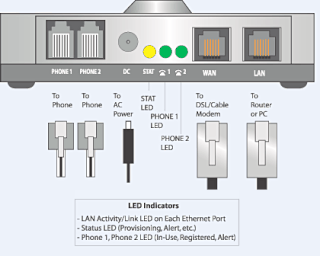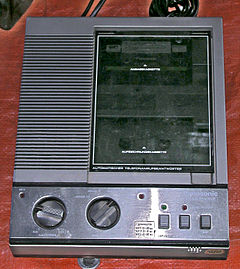
A ringtone is the sound made by a telephone to indicate an incoming telephone call. Originally referring to the sound of electromechanical striking of bells or gongs, the term refers to any sound by any device alerting of an incoming call.

A voicemail system is a computer-based system that allows users and subscribers to exchange personal voice messages; to select and deliver voice information; and to process transactions relating to individuals, organizations, products, and services, using an ordinary phone. The term is also used more broadly to denote any system of conveying a stored telecommunications voice messages, including using an answering machine. Most cell phone services offer voicemail as a basic feature; many corporate private branch exchanges include versatile internal voice-messaging services, and *98 vertical service code subscription is available to most individual and small business landline subscribers.

A telephone call or telephone conversation, also known as a phone call or voice call, is a connection over a telephone network between the called party and the calling party. Telephone calls started in the late 19th century. As technology has improved, a majority of telephone calls are made over a cellular network through mobile phones or over the internet with Voice over IP. Telephone calls are typically used for real-time conversation between two or more parties, especially when the parties cannot meet in person.
Call waiting is a telephone service where a subscriber can accept a second incoming telephone call by placing an in-progress call on hold—and may also switch between calls. With some providers it can be combined with additional features such as conferencing, call forwarding, and caller ID. Call waiting is intended to alleviate the need to have more than one telephone line or number for voice communications.
A beep is a short, single tone, typically high-pitched, generally made by a computer or other machine. The term has its origin in onomatopoeia. The word "beep-beep" is recorded for the noise of a car horn in 1929, and the modern usage of "beep" for a high-pitched tone is attributed to Arthur C. Clarke in 1951.
Last-call return, automatic recall, or camp-on, is a telecommunication feature offered by telephony service providers to subscribers to provide the subscriber with the telephone number, and sometimes the time, of the last caller. The service may also offer the facility to place a call to the calling party.

An analog telephone adapter (ATA) or FXS gateway, is a device for connecting traditional analog telephones, fax machines, and similar customer-premises devices to a digital telephone system or a voice over IP telephony network.
In telephony, an automated attendant allows callers to be automatically transferred to an extension without the intervention of an operator/receptionist. Many AAs will also offer a simple menu system. An auto attendant may also allow a caller to reach a live operator by dialing a number, usually "0". Typically the auto attendant is included in a business's phone system such as a PBX, but some services allow businesses to use an AA without such a system. Modern AA services can route calls to mobile phones, VoIP virtual phones, other AAs/IVRs, or other locations using traditional land-line phones or voice message machines.
VoIP spam or SPIT is unsolicited, automatically dialed telephone calls, typically using voice over Internet Protocol (VoIP) technology.

A business telephone system is a telephone system typically used in business environments, encompassing the range of technology from the key telephone system (KTS) to the private branch exchange (PBX).
In telephony, a zip tone is a call-progress tone which indicates a new incoming call is either connecting or waiting depending on the application. Unlike a ringtone, which alerts those near a telephone to answer it, a zip tone alerts someone already on the line—for example a telephone operator, call center agent, or telephone subscriber with call waiting service—that action is needed for an incoming call such as pressing a button or reciting a phrase. This way of offering an incoming call to an available call center agent is also referred to as 'call forcing' or 'forced calling'.

PhoneValet Message Center is a discontinued Mac-based multi-line computer-telephony software application from Parliant Corporation. The application provided computer-telephony functionality including voicemail, call recording, and the maintenance of a call history. The system is a combination of software and hardware. PhoneValet was awarded an Eddy award for 2006.
An answering machine is a device for automatically answering telephone calls and recording messages left by callers.
1-5-7-1 is the name of a family of calling features in the United Kingdom, for residential and business telephone lines and for mobile telephones, that are provided by BT Group and several other telephone service providers. The family is named after the telephone number 1571, the special service number that is used to access it. Call Minder is the name of BT's highest level of 1571 service.
A voice modem is an analog telephone data modem with a built-in capability of transmitting and receiving voice recordings over the phone line. Voice modems are used for telephony and answering machine applications. Similar to the Hayes command set used for data modems, in which the host PC commands the modem via a series of commands known as AT commands, there exists a well-defined set of common voice AT commands that are somewhat consistent throughout the industry.
In many voice telephone networks, anonymous call rejection (ACR) is a calling feature implemented in software on the network that automatically screens out calls from callers who have blocked their caller ID information.
Call management is the process of designing and implementing inbound telephone call parameters, which govern the routing of these calls through a network. The process is most prominently utilized by corporations and the call centre industry and has its highest effectiveness when call logging software tools are used. Calls are routed according to the set up of calling features within the given system such as Call queues, IVR menus, Hunt groups and Recorded announcements. Call features provide a customised experience for the caller and maximize the efficiency of inbound call handling. Call management parameters can specify how calls are distributed according to an operator's skill level in relation to a call, the time and/or date of a call, the location of the caller or through automatic routing processes.
An automatic dialer is an electronic device or software program that automatically dials telephone numbers. Once the call has been answered, the autodialer either plays a recorded message or connects the call to a live person.
A wireless home phone service is a service that allows a regular wired telephone to connect to a cellular network, as if it were a mobile phone. It is an example of a wireless last mile connection to the public switched telephone network, also known as a wireless local loop.









